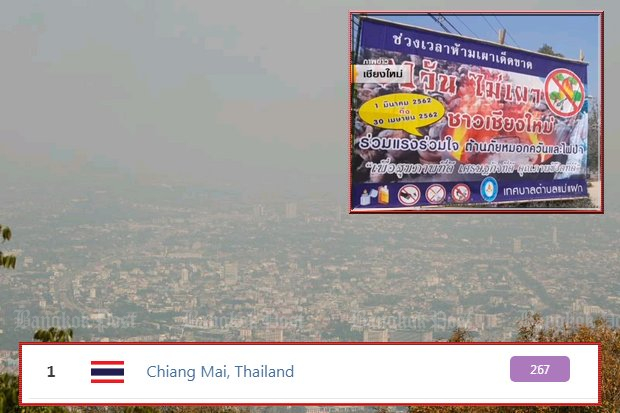
Chiang Mai's air quality was ranked among the world's worst for a third consecutive day Wednesday as haze continued to choke the North.
The air quality index at noon Wednesday was logged at 265, the highest in the world at that moment, according to the AirVisual App, a well-known online air monitoring site. The level of PM 2.5 atmospheric particulate matter was recorded at 214 microgrammes per cubic metre (?g/m?).
Such a level is considered harmful to health. The World Health Organisation (WHO) caps the acceptable level of PM2.5 at 25 μg/m³, and the threshold for Thailand's Pollution Control Department (PCD) is 50 μg/m³.
Chiang Mai provincial officials were spraying water in a desperate attempt to reduce the haze. The attempt barely yielded results as the air quality remained at harmful levels the whole day.
The levels prompted Chiang Mai University to cancel classes for Wednesday and Thursday.
The city was among many towns in nine provinces enshrouded by haze caused by a combination of forest fires, open burning, trans-boundary haze from Lao and Myanmar as well as weather conditions.
Disaster Prevention and Mitigation Department chief, Chayaphon Thitisak, told reporters that branch offices in affected provinces were on full alert to combat forest fires and haze cloaking much of the North.
Officials were monitoring the haze situation, air quality and trying to prevent forest and farm fires. The were also seeking the cooperation of local residents not to burn garbage or agricultural waste.
PCD reported that the nine provinces with PM2.5 readings exceeding the safe level of 50 μg/m³ were Chiang Rai, Chiang Mai, Lampang, Lamphun, Mae Hong Song, Nan, Phrae, Phayao, and Tak.
The PM2.5 level in those areas ranged from 67-167 μg/m³.
Haze has been a seasonal problem in the North for over a decade. It usually appears from January to April, but peaks in March as the extremely dry conditions, open burning and transboundary haze increase the magnitude of forest fires.
Adverse weather conditions over the past week could last until April, according to the Geo-Informatics and Space Technology Development Agency. It said the number fires nationwide this year has exceed the number recorded last year.